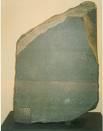THE ROSETTA STONE OF ANCIENT EGYPT
The hieroglyphic words pictures painted on Egyptian ruins were a mystery for many centuries. No one could translate them. That was true until a lucky discovery in 1799 when French soldiers were digging the foundation for an addition to a fort in the Egyptian town of el-Rashid or Rosetta. The soldiers  found a large stone weighing some 1,676 pounds. It had gray, blue and pink hues to it and was inscribed with writing along with hieroglyphics. Napoleon took possession of it. After Napoleon’s defeat, the stone was taken by the English under the terms of the treaty of Alexandria along with other antiquities the French had found.
found a large stone weighing some 1,676 pounds. It had gray, blue and pink hues to it and was inscribed with writing along with hieroglyphics. Napoleon took possession of it. After Napoleon’s defeat, the stone was taken by the English under the terms of the treaty of Alexandria along with other antiquities the French had found.
When it was studied carefully, it was found to have writings in Egyptian and Greek, but using three scripts. These included hieroglyphic, demotic and Greek. Those were the three scripts in use, in Egypt, at the time it was carved. Three scripts were used so that the priests, government officials and rulers of Egypt could read what it said. It was determined to have been carved in 196 B.C.
The stone listed all of the accomplishments of the pharaoh of that era. Many scholars studied the stone and worked to decipher it over a long period of time. The structure of the script was very difficult to decipher. Then in 1882 a French scholar was able to decipher the hieroglyphs. He could read both Green and Coptic. He was able to understand what the seven demotic signs in Coptic were. By using these signs he compared them to the hieroglyphic signs. Once he figured out what some of the hieroglyphs stood for, he was able to make educated guesses about what the others meant as well. Based upon this analysis a translation was made of the Egyptian hieroglyphs found inscribed all over  ancient ruins in Egyptian which, until that time, had remained a mystery to scholars. As a result of the discovery of this one stone in the small village of Rosetta scholars were, for the first time in history, able to read the hieroglyphs of ancient Egypt.
ancient ruins in Egyptian which, until that time, had remained a mystery to scholars. As a result of the discovery of this one stone in the small village of Rosetta scholars were, for the first time in history, able to read the hieroglyphs of ancient Egypt.
The Rosetta stone itself can be seen in the British Museum where it has been since 1802. In World War I the Museum worried about bombing in London so they moved it to safety. It remained in the Postal Tube Railway, some fifty feet below ground, for two years. It was put on exhibition at the Louvre Museum in October of 1972 for the 150th anniversary of the decipherment by the French scholar Jean-Francois Champollion.
A chance discovery of one object opened the door to translating hundreds of hieroglyphs which had been locked from understanding for centuries.

0 thoughts on “THE ROSETTA STONE OF ANCIENT EGYPT”
Belli and Wellington D. Rankin, Atty, Helena Montan, tried acase in Butte Montana several years ago, one of his early cases, each day Belli would come into the court with a exhibit wrapped in butcher paper, and during the day for several days he would move it, from table to the floor etc., the case was about a guy who lost his leg and in the butcher paper was the artificial leg, unwrapped as a display to the Jury. For several years I had a check, that I ran thru the bank 3 times stamped insufficient funds from Belli for l,700 dollars, I framed it and hung it in my office, Dan Sullivan did not apperciate my display of the check so he paid me the l,700 dollars and took the check. I did 3 cases for Belli and enjoyed his stories. CB